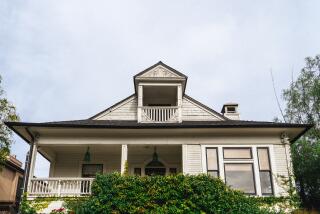BOOK REVIEW : An Elegant Tale of Escapism and Mystery : WAKEFIELD HALL; <i> Francesca Stanfill</i> ; Villard Books $23, 401 pages
“Wakefield Hall” is classy, elegant escape literature for women who know enough to know that they want to be somewhere else.
The escape in this case is not into eroticism (although strong, brooding, fiery, very rich men abound) but into houses, ways of living: life itself pummeled into exceedingly high--celestially high--domestic order.
Elisabeth Rowan is a 31-year-old Wall Street journalist. She dresses exquisitely and has a few amazing jewels, because for the last three years she’s been the mistress--and here that old-fashioned term is perfectly appropriate--of self-made magnate Jack Varady. He placates her with those jewels and furs while he waffles about whether to leave his wife and four children.
Elisabeth receives an invitation from ruthless financier David Cassel to write an authorized biography of his deceased wife, Shakespearean actress Joanna Eakins.
Elisabeth accepts with alacrity: She’s always been a fan of the actress. Besides, much of her own life has been a mystery; how irresistible is the offer to put someone else’s life in order. Elisabeth is summoned, then, to a more-than-lovely estate in the English style, hidden away in the New Hampshire countryside, Wakefield Hall.
And here begins a thoughtful study of order/disorder, domestic calm versus creative chaos, the question of whether money can buy the objects that might actually add up to happiness.
The late Joanna Eakins Cassel had restored Wakefield Hall to a terrestrial paradise, with rambling gardens, a maze with many statues, and rooms that taken together provide perfect well-being and calm. And yet, for this garden of earthly delights, “to take on this project,” she had paid a terrible price.
She had married a moneyed boor, been the lover of yet another moneyed boor, and given up a child for adoption on command. Joanna Eakins, who was born in a log cabin in Wyoming and raised by a drunken mother, “sold out,” for all the appurtenances of an orderly, worldly life.
As a subconscious self-inflicted punishment, she was afflicted in the last stages of her career with debilitating stage fright: a self-imposed silence.
She in effect ruined her own career. As it turned out, the most beautiful possessions in the world were unable to allay the depths of her sorrow.
There are parallels to all of this in her biographer’s career. Elisabeth also comes from a mysterious background. She has never known her mother. Her own lover is so rich that at times Elisabeth doubts her own love for him. She, too, is searching for calm, for security, for her own children, for a domestic heaven-on-Earth.
And, like Joanna, Elisabeth is obsessed with details: The octagonal study at Wakefield Hall, the number of turns in the maze, the designs on the walls of every room she goes into--all those details that make up domestic perfection.
When Elisabeth meets the mysterious Christina Von Shouse, Joanna’s best friend, the journalist intuits the nature of her character from her New York apartment, an exotic Russian design full of deep reds, dark blues and art objects that signal both perfect taste and clanking wealth.
On another fateful afternoon, Elisabeth drives to the Hamptons to meet Lawrence Brandt, the architect who, with Joanna, restored Wakefield Hall. But she stops to sneak a glance at the beach house where her own lover, Jack Varady, lives his supposedly unhappy life with his family.
Just a glimpse through the windows at the bleached-wood landings, the straw hats on a shelf, the umbrellas piled in a corner gives Elisabeth the clues that he’s been lying all along; Varady is a very happy family man.
Francesca Stanfill introduces many other dwellings here: Brandt’s handsome house, an enormous English country home, Thistleton, on which Wakefield House is based.
Each home functions as a character, signaling a way of life. Each suggests questions about the amount of order any human being is able to impose on his or her life. Each questions the ratio of inner life to outer life. Is it possible to think when you live inside a palace, a domestic monument?
Of course, the best thing about these houses (and about the lofty gothic narrative, with all its references to Shakespeare and Henry Adams) is that there are no kitchen sinks with Formica tops. Or folding card tables. Or television sets.
These are the great houses of the mind--the places we wish we could go to when the kid has been howling for three hours, the air conditioning is on the fritz, and the dog has been sick in the den, but you can’t find exactly where .
Escape! It’s summer, the proper time for this kind of diversion.
Francesca Stanfill’s book is a mystery thriller; its plot should not be revealed, but in addition to all the dark secrets, you’ll come away with a crash course in interior design, a set of Cliff Notes on Shakespeare, and a working knowledge of what people wear to black-tie dinner parties in New York.
More to Read
Sign up for our Book Club newsletter
Get the latest news, events and more from the Los Angeles Times Book Club, and help us get L.A. reading and talking.
You may occasionally receive promotional content from the Los Angeles Times.






